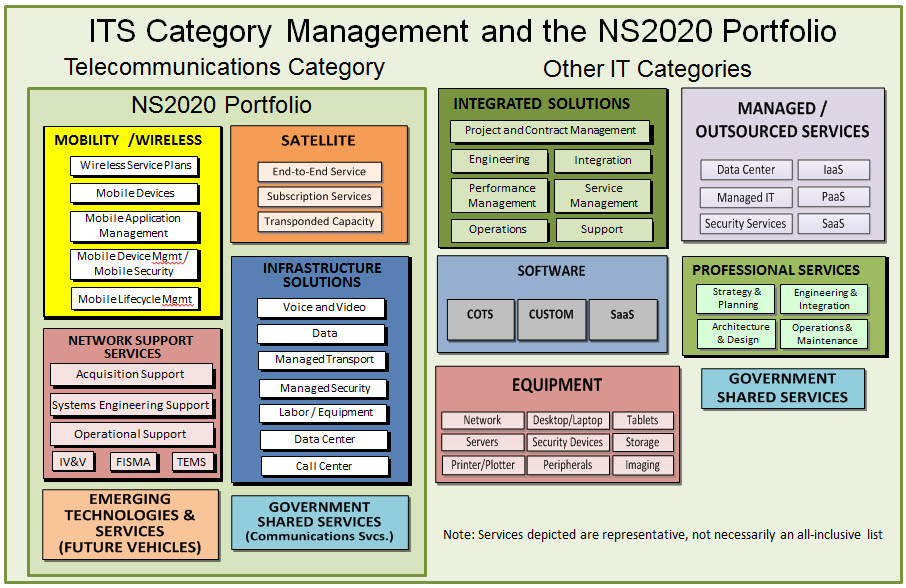(Note: This is a guest blog post by Casey Kelley, acting director for the Office of IT Services within ITC, General Services Administration’s (GSA) Federal Acquisition Service (FAS). As the acting director, Kelley is responsible for a $14+ billion portfolio of contracts that provide federal, state, local, and tribal government agencies with a diverse set of information technology solutions.)
The FAS IT Services portfolio team played a significant role in driving mission delivery of IT capabilities across government during fiscal year (FY) 2016. By providing expertise and procurement support through customer engagement, governmentwide contract vehicles and Best-in-Class (BIC) acquisition solutions, GSA helped government agencies acquire innovative technologies, reduce duplicative enterprise contracts, and improve internal efficiencies.
Customer Engagement is Key to Success
The IT Services team considers customer engagement the key to success, working across government with our agency partners to:
- Share best practices and ideas
- Drive IT innovation to help support mission requirements
- Resolve governmentwide IT challenges (i.e., systems integration through data center optimization)
- Improve acquisition solutions and availability of data and information
We measure our success directly on agencies’ ability to acquire the best IT solutions and services at competitive pricing to meet mission requirements. Customer and industry feedback is an important tool. Listening allows us to understand strategic and tactical requirements and offer the right solution. So, whether it’s an IT Schedule 70 solution, a GWAC, or another IT contract or program, we will have the right solution for agencies looking to acquire anything IT.
IT Schedule 70
IT Schedule 70 offers more than 7.5 million products, services, and solutions from more than 4,600 contract holders. We constantly scan the market to ensure we are adding new products and services, adding new innovative companies, and working with federal, state, local and tribal agencies to meet specific needs and demands.
Agencies that choose IT Schedule 70 can boost their return on investment by maximizing their budgets and reducing procurement lead times by up to 50% over open market purchases. Further, in the past two fiscal years, IT Schedule 70 has experienced increased usage by agencies—$14.8 billion in FY 2015 and $15.1 billion in FY 2016 with about half of those purchases were for IT services. And these figures also include state and local government utilization of IT Schedule 70.
GWACs
Because they deliver a broad range of comprehensive, flexible, easy to use, and innovative solutions, government agencies continue to use GWACs for small through very large, complex requirements. Spending for FY 2016 on GSA GWACs was $6.2 billion:
- 8(a) STARS II – $1.4 billion
- VETS – $126 million
- Alliant – $3.4 billion
- Alliant Small Business – $1.3 billion
Looking Forward: Best-in-Class
For FY 2017, the IT Services team is pursuing Best in Class (BIC) designation for the Alliant GWAC. Best-in-Class is a contracting and acquisition classification used across government to denote contracts that meet rigorous category management performance criteria as defined by the Office of Federal Procurement Policy and approved by the Category Management Leadership Council. A BIC designation recognizes these contracts as ‘good-for-government’ purchasing solutions that should be used by all agencies. BIC solutions are designed to meet specific criteria that helps maximize IT value for government agencies. BIC qualities include:
- Developing contract solutions in partnership with agency customers
- Applying Category Management principles
- Maintaining consistent and constant collaboration with government agencies and industry partners
- Using transactional data to improve product offerings
- Demonstrating a commitment to small business
- Using Processes to monitor, improve and report pricing and buying patterns to help agencies make more informed decisions
Over the Horizon
Special Item Number (SINs)
Moving forward, the IT Services team will be focusing their efforts on two of the newer IT Schedule 70 SINs:
- Health IT SIN (132-56) – includes various Health IT services (e.g., connected health, electronic health records, health information exchanges, Health analytics, Personal health information management, etc.)
- Cloud SIN (132-40) – includes all cloud services that brings potential efficiency improvements and savings to agencies
The IT Services team will work closely with agencies to ensure the new SINs are meeting government’s needs and to provide training and consulting. They will also continue working with industry to bring more companies into the Schedule 70 program and under the SINs.
The team will also concentrate on the GSA IT Schedule 70 Professional Services SIN (132-51), which is the largest Schedule 70 SIN in terms of dollars. Exploring and applying some of the successful industry-customer collaboration best practices used by the GSA Alliant GWAC program will also help us understand how to leverage the new SINs to their full potential.
Open Market Spend
The IT Services team is also working on developing an “open market spend” model for a repeatable process that accurately identifies task orders originally awarded through open market buys.
Alliant and VETS Next Generation GWACs
Finally, the next generation GSA GWACs (Alliant 2, Alliant 2 Small Business GWACs, and VETS 2) are all expected to be awarded and operational in FY18. Once they are in place, the team will begin performing a broad outreach effort to educate and train customers on these latest offerings.
About IT Services
GSA’s IT Services Subcategory, composed of IT Consulting and IT Outsourcing services, is responsible for a portfolio of contracts and programs providing government agencies with a diverse set of IT solutions. To learn more, please visit our IT Consulting and IT Outsourcing Hallways on the Acquisition Gateway.
Also, follow us on Twitter @GSA_ITC and LinkedIn to join our ongoing conversations about government IT.
